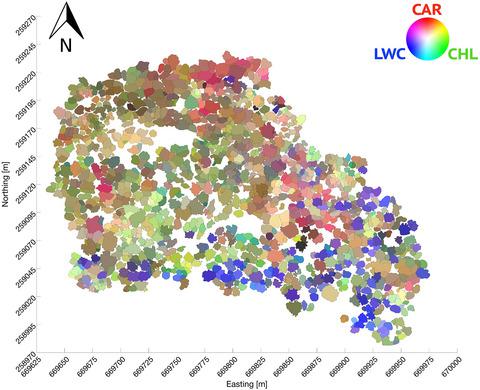当前位置:
X-MOL 学术
›
Ecol. Evol.
›
论文详情
Our official English website, www.x-mol.net, welcomes your feedback! (Note: you will need to create a separate account there.)
Remotely sensed between-individual functional trait variation in a temperate forest
Ecology and Evolution ( IF 2.6 ) Pub Date : 2021-07-22 , DOI: 10.1002/ece3.7758 Carla Guillén-Escribà 1, 2 , Fabian D Schneider 1, 3 , Bernhard Schmid 1 , Andrew Tedder 4 , Felix Morsdorf 1 , Reinhard Furrer 5, 6 , Andreas Hueni 1 , Pascal A Niklaus 7 , Michael E Schaepman 1
中文翻译:

温带森林个体间功能性状的遥感变异
更新日期:2021-08-16
Ecology and Evolution ( IF 2.6 ) Pub Date : 2021-07-22 , DOI: 10.1002/ece3.7758 Carla Guillén-Escribà 1, 2 , Fabian D Schneider 1, 3 , Bernhard Schmid 1 , Andrew Tedder 4 , Felix Morsdorf 1 , Reinhard Furrer 5, 6 , Andreas Hueni 1 , Pascal A Niklaus 7 , Michael E Schaepman 1
Affiliation

|
- Trait-based ecology holds the promise to explain how plant communities work, for example, how functional diversity may support community productivity. However, so far it has been difficult to combine field-based approaches assessing traits at the level of plant individuals with limited spatial coverage and approaches using remote sensing (RS) with complete spatial coverage but assessing traits at the level of vegetation pixels rather than individuals. By delineating all individual-tree crowns within a temperate forest site and then assigning RS-derived trait measures to these trees, we combine the two approaches, allowing us to use general linear models to estimate the influence of taxonomic or environmental variation on between- and within-species variation across contiguous space.
- We used airborne imaging spectroscopy and laser scanning to collect individual-tree RS data from a mixed conifer-angiosperm forest on a mountain slope extending over 5.5 ha and covering large environmental gradients in elevation as well as light and soil conditions. We derived three biochemical (leaf chlorophyll, carotenoids, and water content) and three architectural traits (plant area index, foliage-height diversity, and canopy height), which had previously been used to characterize plant function, from the RS data. We then quantified the contributions of taxonomic and environmental variation and their interaction to trait variation and partitioned the remaining within-species trait variation into smaller-scale spatial and residual variation. We also investigated the correlation between functional trait and phylogenetic distances at the between-species level. The forest consisted of 13 tree species of which eight occurred in sufficient abundance for quantitative analysis.
- On average, taxonomic variation between species accounted for more than 15% of trait variation in biochemical traits but only around 5% (still highly significant) in architectural traits. Biochemical trait distances among species also showed a stronger correlation with phylogenetic distances than did architectural trait distances. Light and soil conditions together with elevation explained slightly more variation than taxonomy across all traits, but in particular increased plant area index (light) and reduced canopy height (elevation). Except for foliage-height diversity, all traits were affected by significant interactions between taxonomic and environmental variation, the different responses of the eight species to the within-site environmental gradients potentially contributing to the coexistence of the eight abundant species.
- We conclude that with high-resolution RS data it is possible to delineate individual-tree crowns within a forest and thus assess functional traits derived from RS data at individual level. With this precondition fulfilled, it is then possible to apply tools commonly used in field-based trait ecology to partition trait variation among individuals into taxonomic and potentially even genetic variation, environmental variation, and interactions between the two. The method proposed here presents a promising way of assessing individual-based trait information with complete spatial coverage and thus allowing analysis of functional diversity at different scales. This information can help to better understand processes shaping community structure, productivity, and stability of forests.
中文翻译:

温带森林个体间功能性状的遥感变异
- 基于特征的生态学有望解释植物群落的运作方式,例如,功能多样性如何支持群落生产力。然而,到目前为止,很难将基于实地的方法在空间覆盖有限的植物个体水平上评估性状与使用具有完整空间覆盖但在植被像素而不是个体水平上评估性状的遥感 (RS) 方法结合起来。 . 通过描绘温带森林场地内的所有个体树冠,然后将 RS 衍生的特征测量值分配给这些树木,我们将这两种方法结合起来,使我们能够使用一般线性模型来估计分类学或环境变化对树木之间的影响。跨连续空间的物种内变异。
- 我们使用机载成像光谱和激光扫描从山坡上的针叶树 - 被子植物混合林中收集单棵树 RS 数据,该森林覆盖了超过 5.5 公顷的山坡,覆盖了大的海拔环境梯度以及光照和土壤条件。我们从 RS 数据中推导出了三种生化(叶绿素、类胡萝卜素和含水量)和三种建筑特征(植物面积指数、叶高多样性和冠层高度),这些特征以前曾用于表征植物功能。然后,我们量化了分类学和环境变异的贡献及其对性状变异的相互作用,并将剩余的种内性状变异划分为较小尺度的空间变异和残差变异。我们还在种间水平上研究了功能性状与系统发育距离之间的相关性。森林由 13 种树种组成,其中 8 种数量充足,可进行定量分析。
- 平均而言,物种之间的分类变异占生化性状变异的 15% 以上,但在建筑性状中仅占 5% 左右(仍然非常显着)。物种间的生化性状距离与系统发育距离的相关性也比建筑性状距离更强。光照和土壤条件以及海拔在所有性状上解释了比分类学更多的变化,但特别是植物面积指数(光照)增加和冠层高度(海拔)降低。除了叶高多样性外,所有性状都受到分类学和环境变异之间显着相互作用的影响,八种物种对场地内环境梯度的不同反应可能有助于八种丰富物种的共存。
- 我们得出的结论是,使用高分辨率 RS 数据,可以描绘森林内的单个树冠,从而评估从个体水平的 RS 数据得出的功能特征。满足这个先决条件后,就可以应用基于田间性状生态学中常用的工具将个体之间的性状变异划分为分类学甚至可能是遗传变异、环境变异以及两者之间的相互作用。这里提出的方法提供了一种有前景的方法来评估具有完整空间覆盖的基于个体的特征信息,从而允许在不同尺度上分析功能多样性。这些信息有助于更好地了解塑造森林群落结构、生产力和稳定性的过程。


























 京公网安备 11010802027423号
京公网安备 11010802027423号